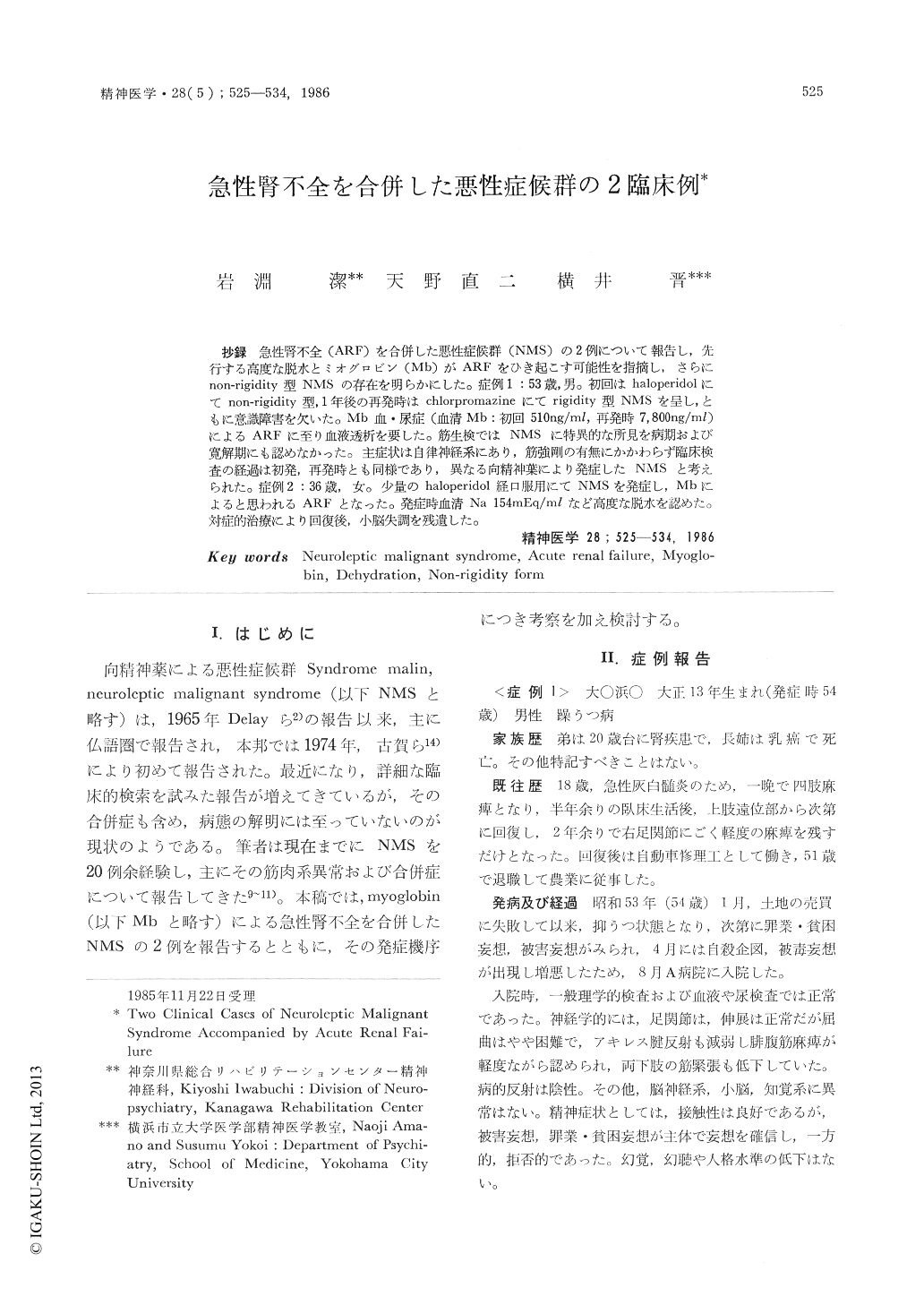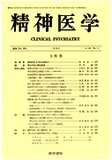Japanese
English
- 有料閲覧
- Abstract 文献概要
- 1ページ目 Look Inside
抄録 急性腎不全(ARF)を合併した悪性症候群(NMS)の2例について報告し,先行する高度な脱水とミオグロビン(Mb)がARFをひき起こす可能性を指摘し,さらにnon-rigidity型NMSの存在を明らかにした。症例1:53歳,男。初回はhaloperidolにてnon-rigidity型,1年後の再発時はchlorpromazineにてrigidity型NMSを呈し,ともに意識障害を欠いた。Mb血・尿症(血清Mb:初回510ng/ml,再発時7,800ng/ml)によるARFに至り血液透析を要した。筋生検ではNMSに特異的な所見を病期および寛解期にも認めなかった。主症状は自律神経系にあり,筋強剛の有無にかかわらず臨床検査の経過は初発,再発時とも同様であり,異なる向精神葉により発症したNMSと考えられた。症例2:36歳,女。少量のhaloperidol経口服用にてNMSを発症し,Mbによると思われるARFとなった。発症時血清Na 154mEq/mlなど高度な脱水を認めた。対症的治療により回復後,小脳失調を残遺した。
This paper is a report of two cases of neuroleptic malignant syndrome (NMS). Both cases followed a peculiar clinical course. Examining the findings observed in these two cases, we must emphasize that the recurrence of NMS may be caused by a different kind of the neuroleptica and that there are the clinical manifestations of the condition which are devoid of muscular rigidity of the extremities. This is socalled "non-rigid form". In some cases, the NMS may result in acute renal failure due to myoglobinemia. This is a severe complication which is preceded by remarkable dehydration.
Case 1: A male, 51-year-old, suffering from depression. When he was 18 years old, he was afflicted with poliomyelitis. Since his recovery, he had worked as a farmer. The first NMS developed after medication of per os (5-20mg a day) and intramuscular injection of haloperidol for about 3 weeks. He did not develop muscular rigidity of his extremities during the course of medication, but autonomic disorder was severe ; fever of unknown origin, profound perspiration, tachycardia and so on. Laboratory findings showed marked elevation of the level of muscular enzymes (creatinine kinase 11,270 Iu, aldolase 71 u, etc.) and dehydration. The second NMS was induced by chlorpromazine (25mg only by intramuscular injection). He showed muscular rigidity of his extremities with severe autonomic disorders. He did not show any disturbances of consciouness during either course. The laboratory data demonstrated myoglobinemia (the first : 510ng/ml, the second : 7, SOOng/ml). Thereafter, he became afflicted with acute renal failure. However, he recoverd on both occasions after treatment by hemodialysis.
The biopsied muscle revealed negative sensitivity of the muscle towards haloperidol in the contraction test. Histochemical study showed group atrophy of type II fibers predominantly in the lower extremities, but no difference could be found between the muscle during NMS and during remission. The neurogenic patterns were demonstrated in the upper and lower extremities by electromyography. Therefore, we think that these conditions were caused by poliomyelitis when he was 18 years old.
To sum up, the chief symptoms in this case were the disturbance of the autonomic systems. The laboratory data both at the time of NMS and at the time of remission were similar, regardless of the presence or non-presence of muscular rigidity. Acute renal failure was induced by myoglobinemia accompanied by severe dehydration.
Case 2 : A female, 36-year-old schizophrenic. The NMS was induced by a small dosage of haloperidol per os. She developed acute renal failure due to myoglobinuria and disturbance of consciousness. The laboratory data demonstrated that serum Na was 154mEq/ml, hematocrit 48.9% showing severe dehydration. After the improvement of the NMS, she developed dysarthria and cerebellar signs, namely, truncal ataxia, and was unable to sit down. About one year later, it became possible for her to walk alone. A head CT scan 2 years later revealed cerebellar atrophy and the cerebellar signs were not improved. She did not have any muscular atrophy and EMG demonstrated normal pattern. She showed no mental deterioration.

Copyright © 1986, Igaku-Shoin Ltd. All rights reserved.


